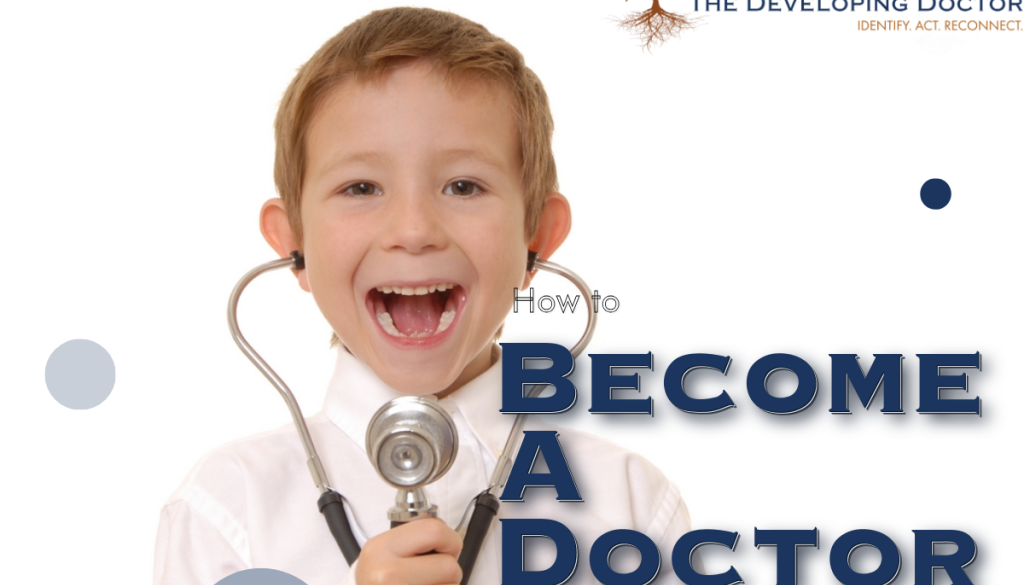How to Become a Doctor: Real Steps, Real Talk, and Premed Advice You Actually Need
Dream about becoming a doctor?
Good.
The world needs you.
But you deserve the truth: it’s a long, brutal road.it’s also one of the most meaningful careers you can think of.
Let’s cut through the noise. Here’s exactly how to become a doctor today, no sugarcoating, no fluff.
Follow these steps and you will set yourself up for success!
Step 1: Crush High School (Yes, It Starts Early)
Think you’re “just” a high school student?
Wrong.
You’re already building the habits and mindset you’ll need to survive (and thrive) later.
Action Steps:
- Stack your schedule with science courses: biology, chemistry, physics.
- Practice managing heavy workloads without burning out. Learn how to study, manage your time, and juggle different tasks.
- Start exploring healthcare careers—shadow doctors, volunteer, ask questions.
- Learn about your self. Like music? Join the band. Want to run a marathon? Go out for cross country. Learn what you like and don’t like now. Your hobbies and outside interests will sustain you through some tought times ahead!
Step 2: Choose the Right College Major (Hint: It’s Not Just “Premed”)
You do not have to major in biology. (Unless you love it.)
Medical schools want to see you can handle tough science courses, not that you followed some cookie-cutter path. They also want to learn about you. Tell a story about your interests, strengths, and struggles through the classes you take and the activities you participate in.
Action Steps:
- Pick a major you actually like.
- Knock out required courses (biology, chemistry, organic chemistry, physics, math, English).
- Get clinical experience: scribing, shadowing, volunteering.
- Build real relationships with mentors for future recommendation letters.
Step 3: Conquer the MCAT (and Your Inner Doubt)
The MCAT isn’t just a test. It’s a gut check.
Studying for the MCAT is also a chance to reinforce concepts that will be important in medical school.
Action Steps:
- Plan to study 300–500 hours minimum.
- Use full-length practice exams—timed and brutal. Learn how to prace yoursefl. Any questions left unanswered is 100% wrong. Any question you answer has a 25% chance of being right. Make sure you answer every question.
- Treat your mental game like your physical game. Sleep. Eat. Move.
Step 4: Apply to Medical School (And Play the Numbers Game)
Think applying is just about grades? Nope. It’s about telling a story. Your story.
Make sure your story is consistent and honest. If you mention you are interested in research but haven’t spent any time performing research that is a red flag. Don’t tell the admissions committee what you think they want to hear. Tell then the truth. Tell them your truth!
Application Must-Haves:
- Competitive MCAT (average for MD admits: 511.7; DO admits: 504.8 in 2024)
- Solid GPA (average MD GPA: 3.74, DO GPA: 3.56)
- An honest, consistent personal statement
- Prove you know what you are getting into by shadowing, participating research, and engaging in service activities.
- Authentic recommendation letters
- Prepare for secondary application essays and interviews
Admissions Data (2024):
– MD Schools: 22,666 matriculants out of ~52,500 applicants (43% acceptance rate)
– DO Schools: 9,350 matriculants out of ~22,708 applicants (41% acceptance rate)
Step 5: Survive (and Own) Medical School
The first two years are science heavy. The exam scheduling is brutal. No one will hold your hand, but they do want to to succeed! Take advantage of the available resources like the counseling center and learning specialists. Learn how to study and keep up with the material.
The last two years are the clinical years. Finally! Real patients. Real stakes.
Action Steps:
- Form a study crew you trust. Adapty quickly. Don’be be afraid to try something new. Cramming not longer works!
- Fail fast, fail often—then move forward.
- Fight perfectionism. Medicine rewards resilience, not flawless grades.
Step 6: Match Into Residency (Where the Real Fun—and Pain—Begins)
Residency is where you specialize. Internal medicine. Surgery. Pediatrics. Psychiatry.
It’s also where you’ll question your life choices at 3AM. The hourse are long but worth it.
Action Steps:
- Crush USMLE or COMLEX Step exams
- Build relationships with attendings (they can make or break your career)
- Apply smart: back-up options are not weakness—they’re wisdom
Step 7: Get Licensed. Get Paid. Get Free (Sort Of.)
You pass your final licensing exams.
>You get your medical license.
>You start your real career.
But here’s the real talk:
This system is broken.
Burnout is real.
Autonomy isn’t handed to you—you have to take it.
You didn’t come this far just to become a cog in a broken machine.
Frequently Asked Questions (FAQ)
How many years does it take to become a doctor?
Roughly 11–15 years total: 4 years college → 4 years med school → 3–7 years residency.
Is it easier to get into DO schools than MD schools?
Statistically, yes—slightly. DO schools have lower average MCAT and GPA thresholds. But “easier” still means insanely competitive.
Can I major in something non-science?
Yes! You just need to complete the required science courses alongside your major.
What if I don’t get into med school the first time?
It’s common. About 50–60% of applicants don’t get in on the first try. Reapplying with a stronger application is 100% possible.
How important is clinical experience before applying?
Crucial. Admissions committees want proof you understand what being a doctor actually means. No experience = no credibility.
Final Word: You Can Do This—But Only If You Want It Bad Enough
Becoming a doctor is messy.
Painful.
Glorious and absolutely worth it for those who want to be challenges, serve others, and make a great living.
It’s not for everyone.
But if it’s for you—you’ll find a way.
So the real question isn’t just how to become a doctor.
It’s: How hard are you willing to fight for the life you want?
The tools are in front of you.
The time is now.
Let’s go.





